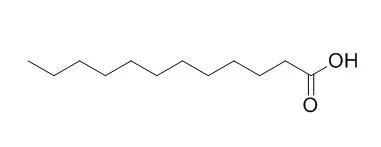| Description: |
Lauric acid is a middle chain-free fatty acid with strong bactericidal properties. The EC50s for P. acnes, S.aureus, S. epidermidis, are 2, 6, 4 μg/mL, respectively. Lauric acid displays preferential antineoplastic property, including induction of apoptosis in a CRC cell line. |
| Targets: |
IL Receptor | TNF-α | NF-kB | ROS | MAPK |
| In vitro: |
| J Exp Bot. 2014 Jan;65(1):131-41. | | Lauric acid in crown daisy root exudate potently regulates root-knot nematode chemotaxis and disrupts Mi-flp-18 expression to block infection.[Pubmed: 24170741] | Tomato (Solanum lycopersicum) crops can be severely damaged due to parasitism by the root-knot nematode (RKN) Meloidogyne incognita, but are protected when intercropped with crown daisy (Chrysanthemum coronarium L.). Root exudate may be the determining factor for this protection.
METHODS AND RESULTS:
An experiment using pots linked by a tube and Petri dish experiments were undertaken to confirm that tomato-crown daisy intercropping root exudate decreased the number of nematodes and alleviated nematode damage, and to determine crown daisy root exudate-regulated nematode chemotaxis. Following a gas chromatography-mass spectrometry assay, it was found that the intercropping protection was derived from the potent bioactivity of a specific root exudate component of crown daisy, namely Lauric acid. The Mi-flp-18 gene, encoding an FMRFamide-like peptide neuromodulator, regulated nematode chemotaxis and infection by RNA interference. Moreover, it was shown that Lauric acid acts as both a lethal trap and a repellent for M. incognita by specifically regulating Mi-flp-18 expression in a concentration-dependent manner. Low concentrations of Lauric acid (0.5-2.0mM) attract M. incognita and consequently cause death, while high concentrations (4.0mM) repel M. incognita. This study elucidates how Lauric acid in crown daisy root exudate regulates nematode chemotaxis and disrupts Mi-flp-18 expression to alleviate nematode damage, and presents a general methodology for studying signalling systems affected by plant root exudates in the rhizosphere.
CONCLUSIONS:
This could lead to the development of economical and feasible strategies for controlling plant-parasitic nematodes, and provide an alternative to the use of pesticides in farming systems. |
|
| In vivo: |
| J Dermatol Sci. 2014 Mar;73(3):232-40. | | Anti-bacterial and anti-inflammatory properties of capric acid against Propionibacterium acnes: a comparative study with lauric acid.[Pubmed: 24284257] | Propionibacterium acnes (P. acnes) is a commensal bacterium which is possibly involved in acne inflammation. The saturated fatty acid, Lauric acid (C12:0) has been shown to possess antibacterial and anti-inflammatory properties against P. acnes. Little is known concerning the potential effects of its decanoic counterpart, capric acid (C10:0).
To examine the antibacterial and anti-inflammatory activities of capric acid against P. acnes and to investigate the mechanism of the anti-inflammatory action.
METHODS AND RESULTS:
The antimicrobial activity of fatty acids was detected using the broth dilution method. An evaluation of P. acnes-induced ear edema in mice was conducted to evaluate the in vivo anti-inflammatory effect. To elucidate the in vitro anti-inflammatory effect, human SZ95 sebocytes and monocytic THP-1 cells were treated with P. acnes alone or in the presence of a fatty acid. The mRNA levels and secretion of pro-inflammatory cytokines were measured by qRT-PCR and enzyme immunoassay, respectively. NF-κB activation and MAPK expression were analyzed by ELISA and Western blot, respectively.
Lauric acid had stronger antimicrobial activity against P. acnes than capric acid in vitro and in vivo. However, both fatty acids attenuated P. acnes-induced ear swelling in mice along with microabscess and significantly reduced interleukin (IL)-6 and CXCL8 (also known as IL-8) production in P. acnes-stimulated SZ95 sebocytes. P. acnes-induced mRNA levels and secretion of IL-8 and TNF-α in THP-1 cells were suppressed by both fatty acids, which inhibited NF-κB activation and the phosphorylation of MAP kinases.
CONCLUSIONS:
Our data demonstrate that both capric acid and Lauric acid exert bactericidal and anti-inflammatory activities against P. acnes. The anti-inflammatory effect may partially occur through the inhibition of NF-κB activation and the phosphorylation of MAP kinases. |
|






 Cell. 2018 Jan 11;172(1-2):249-261.e12. doi: 10.1016/j.cell.2017.12.019.IF=36.216(2019)
Cell. 2018 Jan 11;172(1-2):249-261.e12. doi: 10.1016/j.cell.2017.12.019.IF=36.216(2019) Cell Metab. 2020 Mar 3;31(3):534-548.e5. doi: 10.1016/j.cmet.2020.01.002.IF=22.415(2019)
Cell Metab. 2020 Mar 3;31(3):534-548.e5. doi: 10.1016/j.cmet.2020.01.002.IF=22.415(2019) Mol Cell. 2017 Nov 16;68(4):673-685.e6. doi: 10.1016/j.molcel.2017.10.022.IF=14.548(2019)
Mol Cell. 2017 Nov 16;68(4):673-685.e6. doi: 10.1016/j.molcel.2017.10.022.IF=14.548(2019)